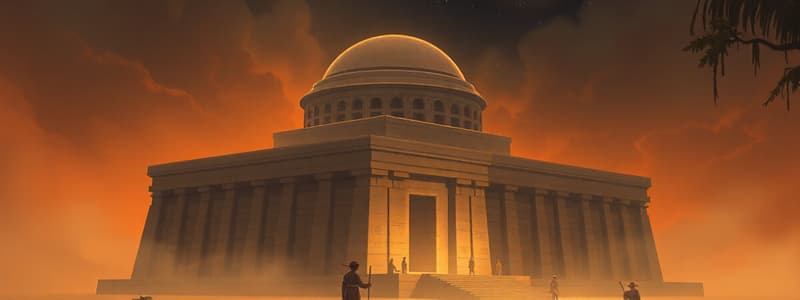Podcast
Questions and Answers
What was the primary focus of the Neolithic Revolution?
What was the primary focus of the Neolithic Revolution?
- Food production (correct)
- Food gathering
- Warfare
- Trade between cultures
The Sumerians created the world's first cities and developed advanced technology.
The Sumerians created the world's first cities and developed advanced technology.
True (A)
Name one major contribution of the Sumerians.
Name one major contribution of the Sumerians.
The wheel
_____ were huge structures built in Sumerian cities.
_____ were huge structures built in Sumerian cities.
Match the following civilizations with their contributions:
Match the following civilizations with their contributions:
Which rivers bounded Mesopotamia?
Which rivers bounded Mesopotamia?
The Epic of Gilgamesh is a historical record of a Sumerian king's journey.
The Epic of Gilgamesh is a historical record of a Sumerian king's journey.
The study of artifacts left behind in historical areas is called _____
The study of artifacts left behind in historical areas is called _____
What major mountain range is located in northern India?
What major mountain range is located in northern India?
The Harappan civilization was primarily located in the eastern part of India.
The Harappan civilization was primarily located in the eastern part of India.
Name the first writing system developed by the Harappan civilization.
Name the first writing system developed by the Harappan civilization.
The __________ is important in the establishment of Egyptian religions and reflects their sophisticated thought.
The __________ is important in the establishment of Egyptian religions and reflects their sophisticated thought.
Match the following ancient cultures with their notable aspects:
Match the following ancient cultures with their notable aspects:
What was the primary agricultural innovation of the Harappan civilization?
What was the primary agricultural innovation of the Harappan civilization?
The Indus River is associated with India's first civilization.
The Indus River is associated with India's first civilization.
Who was the first pharaoh of Egypt?
Who was the first pharaoh of Egypt?
Which of the following is NOT one of the three major gods in Hinduism?
Which of the following is NOT one of the three major gods in Hinduism?
Hindus believe that the world is an illusion.
Hindus believe that the world is an illusion.
What is the ultimate goal in Hinduism?
What is the ultimate goal in Hinduism?
Mahavira is known for establishing the principles of __________.
Mahavira is known for establishing the principles of __________.
What principle is NOT one of Jainism's four basic principles?
What principle is NOT one of Jainism's four basic principles?
Sikhism was founded by Guru Nanak, who was dissatisfied with Hinduism and Islam.
Sikhism was founded by Guru Nanak, who was dissatisfied with Hinduism and Islam.
What do Sikhs believe is necessary to achieve spiritual enlightenment?
What do Sikhs believe is necessary to achieve spiritual enlightenment?
Match each religion with its primary teaching or belief:
Match each religion with its primary teaching or belief:
The Torah is significant in __________ as it contains Jewish religious laws.
The Torah is significant in __________ as it contains Jewish religious laws.
Which group believed they should answer only to God, defining themselves as Orthodox Jews?
Which group believed they should answer only to God, defining themselves as Orthodox Jews?
Flashcards
Neolithic Revolution
Neolithic Revolution
The change from hunting and gathering to farming and raising livestock.
Cuneiform
Cuneiform
A wedge-shaped writing system used by the Sumerians, the first known system of writing in the world.
Ziggurats
Ziggurats
Giant structures built by the Sumerians to honor their gods - like pyramids, but with steps.
Code of Hammurabi
Code of Hammurabi
Signup and view all the flashcards
City-States
City-States
Signup and view all the flashcards
Phoenicians
Phoenicians
Signup and view all the flashcards
Empires
Empires
Signup and view all the flashcards
Archaeology
Archaeology
Signup and view all the flashcards
Subcontinent
Subcontinent
Signup and view all the flashcards
Monsoons
Monsoons
Signup and view all the flashcards
Harappan Civilization
Harappan Civilization
Signup and view all the flashcards
Caste System
Caste System
Signup and view all the flashcards
Pyramids
Pyramids
Signup and view all the flashcards
Kush
Kush
Signup and view all the flashcards
Rosetta Stone
Rosetta Stone
Signup and view all the flashcards
Ka
Ka
Signup and view all the flashcards
Hindu Polytheism
Hindu Polytheism
Signup and view all the flashcards
Hinduism: Ultimate Goal
Hinduism: Ultimate Goal
Signup and view all the flashcards
Karma
Karma
Signup and view all the flashcards
Jainism: Non-Violence
Jainism: Non-Violence
Signup and view all the flashcards
Jainism: Four Principles
Jainism: Four Principles
Signup and view all the flashcards
Sikhism: Origins
Sikhism: Origins
Signup and view all the flashcards
Sikhism: Ultimate Goal
Sikhism: Ultimate Goal
Signup and view all the flashcards
Sikhism: Equality
Sikhism: Equality
Signup and view all the flashcards
Synagogue
Synagogue
Signup and view all the flashcards
Yahweh
Yahweh
Signup and view all the flashcards




